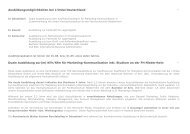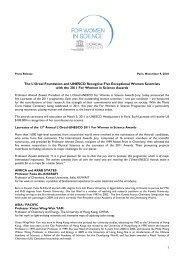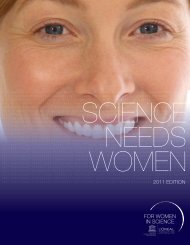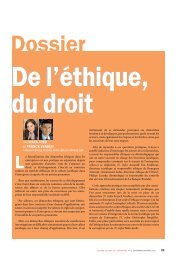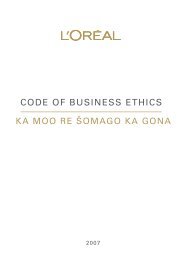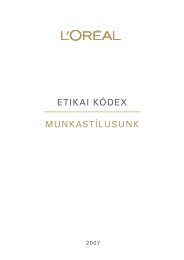2008 L'ORÉAL-UNESCO FOR WOMEN IN SCIENCE 10 YEARS OF ...
2008 L'ORÉAL-UNESCO FOR WOMEN IN SCIENCE 10 YEARS OF ...
2008 L'ORÉAL-UNESCO FOR WOMEN IN SCIENCE 10 YEARS OF ...
Create successful ePaper yourself
Turn your PDF publications into a flip-book with our unique Google optimized e-Paper software.
<strong>2008</strong> L’ORÉAL-<strong>UNESCO</strong> <strong>FOR</strong> <strong>WOMEN</strong> <strong>IN</strong> <strong>SCIENCE</strong><br />
<strong>10</strong> <strong>YEARS</strong> <strong>OF</strong> THE L’ORÉAL-<strong>UNESCO</strong> AWARDS<br />
CONTENTS<br />
� L’ORÉAL-<strong>UNESCO</strong> Awards Laureates 1998-<strong>2008</strong>: fold-out of the 52 Laureates<br />
� The L’ORÉAL-<strong>UNESCO</strong> Awards For Women in Science:<br />
<strong>10</strong> years of commitment p. 2<br />
� The Panorama of Science: seen through the work of the Award Laureates p. 4<br />
� Women and science: Status report p. 7<br />
For further information or interviews with Laureates and Fellowship winners:<br />
Media Relations Agency RUDER F<strong>IN</strong>N<br />
Frédérique IMPENNATI/Juliette BILLAROCH<br />
Tel: +33 (0)1 56 81 15 00<br />
Fax: +33 (0)1 43 25 06 06<br />
fimpennati@ruderfinn.fr / jbillaroch@ruderfinn.fr<br />
<strong>UNESCO</strong><br />
Press Office<br />
Tel: +33 (0)1 45 68 17 48<br />
Fax: +33 (0)1 45 68 56 52<br />
www.unesco.org<br />
L’ORÉAL<br />
Direction of Partnerships & Philanthropy<br />
Tel: +33 (0)1 47 56 42 55<br />
Fax: +33 (0)1 47 56 42 59<br />
Fwis-infos@dgc.loreal.com<br />
Corporate Press Office<br />
Tel: +33 (0)1 47 56 41 95<br />
Fax: +33 (0)1 47 56 40 54<br />
presse@loreal.com<br />
L’ORÉAL-<strong>UNESCO</strong> <strong>FOR</strong> <strong>WOMEN</strong> <strong>IN</strong> <strong>SCIENCE</strong><br />
www.forwomeninscience.com<br />
1/9
THE L’ORÉAL-<strong>UNESCO</strong> AWARDS <strong>FOR</strong> <strong>WOMEN</strong> <strong>IN</strong> <strong>SCIENCE</strong>:<br />
<strong>10</strong> years of commitment<br />
Launched in 1998 by L’ORÉAL and <strong>UNESCO</strong>, the “For Women in Science” Award was the<br />
first international award devoted to women in science. Today it is one element of a broad<br />
program with an international focus on scientific vocations and dedicated to recognizing the<br />
accomplishments of female researchers from every continent.<br />
An Award and a program without precedent, to promote and encourage women who<br />
contribute to scientific progress around the world.<br />
Women all over the world are revolutionizing science. Sometimes ignored and even<br />
discriminated against, women who may have only the image of Marie Curie as a role model<br />
are today participating at the forefront of advances in genetics, physics, biology, and new<br />
technologies. Now in its <strong>10</strong>th year, the “L’ORÉAL-<strong>UNESCO</strong> For Women in Science” program<br />
awards and supports these women who are contributing more and more to the scientific<br />
advancements that are transforming our world. In 1998, L’ORÉAL and <strong>UNESCO</strong> presented<br />
the first international awards.<br />
“Ten years and 52 Laureates later, there is no doubt that this award is fulfilling its promise,”<br />
says Béatrice Dautresme, vice president of L’Oréal, managing director of the L’Oréal<br />
Corporate Foundation and one of the founders of the program. “The Laureates chosen for<br />
their excellence by the international juries become ambassadors and role models for the next<br />
generation of young women.”<br />
Elizabeth Longworth, executive director of the office of the <strong>UNESCO</strong> Director-General,<br />
concurs: “This unique partnership of L’ORÉAL and <strong>UNESCO</strong> is a significant initiative in the<br />
promotion of women and consequently for science all over the world.”<br />
More than just an Award, the program is building a community that helps future<br />
generations of women scientists<br />
This willingness to support future talents has always been the passion and the aim of the<br />
program. From the beginning, L’ORÉAL and <strong>UNESCO</strong> were determined to create more than<br />
a simple prize by ensuring that women scientists get the recognition they deserve. The<br />
Laureates identified by the distinguished scientists who make up the international juries have<br />
made this award one of the most prestigious in science.<br />
L’ORÉAL-<strong>UNESCO</strong> <strong>FOR</strong> <strong>WOMEN</strong> <strong>IN</strong> <strong>SCIENCE</strong><br />
www.forwomeninscience.com<br />
2/9
Each year, more than 1, 000 scientists from around the world are asked to submit the names<br />
of potential candidates for examination by the jury. Two juries review the candidatures, in life<br />
sciences and material sciences in alternating years, presided by leading Nobel Prize<br />
Laureates – biologists Christian de Duve and Gunter Blobel and physicist Pierre-Gilles de<br />
Gennes, who was fervently involved with the awards until his death in May 2007.<br />
Five Laureates from five continents, every year: a unique award that has recognized<br />
52 exceptional women scientists in <strong>10</strong> years<br />
From its very first year, the program “For Women in Science” chose to reward not one<br />
Laureate, but five, one from each of the five continents. The Laureates each receive USD<br />
<strong>10</strong>0,000. “By allocating an award to each continent, it is possible to reward women working<br />
under extremely varying conditions,” observes Christian de Duve, Nobel Prize in Medicine<br />
1974 and Founding President of the Awards. “We have been given a magnificent panorama<br />
of science at the service of humanity.”<br />
120 International Fellowships to encourage scientific vocations<br />
This commitment on a global scale has been reinforced by the creation of fellowship<br />
programs that make the “For Women in Science” initiative an equally unprecedented source<br />
of support. The stakes are high, because behind the successful Laureates is an increasingly<br />
large generation of young women pursuing research. Their problem is not so much lack of<br />
recognition, but rather a lack of necessary means to complete their studies and training.<br />
Since 2000, 120 <strong>UNESCO</strong>-L’ORÉAL international Fellowships, worth up to $40,000 dollars<br />
over two years, have been awarded to doctorate or post-doctorate women from 67 countries<br />
to permit them to pursue their research abroad in some of the most prestigious laboratories<br />
in the world.<br />
Further expansion by the creation of National Fellowship programs<br />
Programs of National Fellowships have also been introduced to help students pursue their<br />
scientific careers. By end <strong>2008</strong>, these local fellowship programs for women doing research in<br />
their home countries will exist in over 50 countries.<br />
The L’ORÉAL-<strong>UNESCO</strong> “For Women in Science” program is not only a benchmark, but has<br />
become a catalyst for the promotion of women and science around the world.<br />
L’ORÉAL-<strong>UNESCO</strong> For Women in Science <strong>2008</strong>:<br />
More than 500 women scientists have been distinguished by the Awards or supported in the<br />
pursuit of their career since the creation of the L’ORÉAL-<strong>UNESCO</strong> partnership:<br />
The L’ORÉAL-<strong>UNESCO</strong> Awards – 52 Laureates from 26 countries<br />
The <strong>UNESCO</strong>-L’ORÉAL International Fellowships – 120 Fellows from 67 countries<br />
The L’ORÉAL National Fellowships with the support of the <strong>UNESCO</strong> National<br />
Commissions – 340 Fellows in 35 countries<br />
(As of 6 March <strong>2008</strong>)<br />
L’ORÉAL-<strong>UNESCO</strong> <strong>FOR</strong> <strong>WOMEN</strong> <strong>IN</strong> <strong>SCIENCE</strong><br />
www.forwomeninscience.com<br />
3/9
THE PANORAMA <strong>OF</strong> <strong>SCIENCE</strong>:<br />
SEEN THROUGH THE WORK <strong>OF</strong> THE AWARD LAUREATES<br />
From molecular biology to the physical sciences, for the past ten years the Laureates of the<br />
“For Women and Science” program have been grappling with the key challenges of cuttingedge<br />
research.<br />
Whether it’s the creation of vaccines or understanding the critical states of matter, the<br />
research of the 52 Laureates (or the applications deriving from their research) will have a<br />
direct impact on tomorrow’s world. As leading scientists, they are actively involved in major<br />
projects and testify to the important but often unrecognized role played by women in the<br />
world of science. Ten key areas emerge from an analysis of the Laureates’ research fields.<br />
1. On the trail of tomorrow’s medicines.<br />
While the 20 th century ushered in the antibiotic revolution, the 21 st has already seen the<br />
launch of new medicines and treatments.<br />
-In 2001, Joan Steitz was honored for elucidating the role played by tiny RNA molecules in<br />
regulating genes. Her research could help in the diagnosis of autoimmune diseases and the<br />
treatment of rheumatic illness.<br />
-In 2002, Mary Osborn was honored for the development of microscopy techniques based<br />
on immunofluorescence which benefit the study of certain cancerous tumours and open up<br />
the way for more carefully targeted treatments.<br />
-In 2004, Philippa Marrack received an award for her discovery of “supergenes”. Her work<br />
resulted in a better understanding of the human immune system and paved the way for<br />
treatments for autoimmune diseases such as asthma and arthritis.<br />
2. The preservation of biodiversity.<br />
Whether we’re talking about fauna or flora, the preservation and propogation of species have<br />
become key issues in modern science.<br />
-In 1998, Gloria Montenegro was distinguished for her botanical work enabling plant<br />
ecosystems to be reconstituted in areas affected by desertification or fire.<br />
-In 2007, Ameenah Gurib-Fakim was honored for research that enabled a inventory to be<br />
taken of the flora of Mauritius (her home country) and new plant-based medical applications<br />
to be identified.<br />
L’ORÉAL-<strong>UNESCO</strong> <strong>FOR</strong> <strong>WOMEN</strong> <strong>IN</strong> <strong>SCIENCE</strong><br />
www.forwomeninscience.com<br />
4/9
3. Controlling major epidemics.<br />
More than a billion people are affected by epidemics, many of which are little known in more<br />
developed countries. The Laureates are playing a key role in the struggle against these<br />
afflictions.<br />
-In 2002, Indira Nath was distingished for her research into leprosy which has helped to<br />
contain the disease in India and may open the way for a future vaccine.<br />
-In 2003, Lucia Mendonça Previato was honored for her research on Chagas’ disease,<br />
which affects between 16 and 18 million people in South America.<br />
-In 2006, Esther Orozco was rewarded for her contribution to a better understanding of the<br />
spreading of parasitical intestinal infections caused by amoeba.<br />
4. Better understanding and prevention of hereditary diseases.<br />
Prenatal diagnosis is leading to a steady improvement in the prevention of pathological<br />
conditions of genetic origin. The Laureates have made key contributions to this progress.<br />
-In 2001, Adeyinka Gladys Falusi was honored for her work in molecular genetics that has<br />
benefited the prenatal diagnosis of hereditary blood diseases of the in Africa.<br />
-In 2003, Christine Petit was distingished for being the first scientist to identify the genetic<br />
origins of deafness in children, opening up the way for better molecular diagnosis.<br />
-In 2006, Habiba Bouhamed Chaabouni was honored for her work in Tunisia which<br />
enabled more effective study and prevention of genetic diseases, often related to issues of<br />
consanguinity.<br />
5. Better understanding of reproduction and evolution.<br />
New reproductive techniques have transformed the lives of more than 300,000 infertile<br />
couples throughout the world. Research is leading to a better understanding of the<br />
mechanisms of reproduction and evolution.<br />
-In 2001, Anne McLaren was honored for her pioneering work in reproductive biology which<br />
paved the way for the first in vitro fertilizations.<br />
-In 2006, Jennifer Graves was distinguished for her work on the transformation of sex<br />
chromosomes which is essential to an understanding of gender differentiation mechanisms in<br />
mammals.<br />
6. Unravelling the secrets of our DNA.<br />
From the way DNA works to the recent identification of micro-DNA, genetic research was a<br />
major revolution of the 20 th century… and of the 21 st century too.<br />
-In 2000, Margarita Salas was honored for research that helped explain DNA’s reproductive<br />
mechanisms.<br />
-In 2000, Tuneko Okazaki was rewarded for her work on retrograde DNA replication. She<br />
contributed to the identification of key fragments in the DNA replication mechanism, called<br />
"Okazaki fragments," which in the future may be used to develop the first artificial human<br />
chromosomes.<br />
-In <strong>2008</strong>, V. Narry Kim was recognized for shedding light on the role played by RNA<br />
molecules in the transmission of genetic information in cells. Her research is expected to<br />
result in new applications in the field of biotechnology.<br />
L’ORÉAL-<strong>UNESCO</strong> <strong>FOR</strong> <strong>WOMEN</strong> <strong>IN</strong> <strong>SCIENCE</strong><br />
www.forwomeninscience.com<br />
5/9
7. The struggle against aging.<br />
A new case of Alzheimer’s disease is diagnosed somewhere in the world every seven<br />
seconds. Modern science has taken up the challenge – both where geriatric diseases are<br />
concerned as well as in the fight against the aging process itself.<br />
-In 2004, Nancy Ip was honored for elucidating the role of proteins in the activation and<br />
development of neurons. Her work has helped in the fight against neurogenerative diseases<br />
such as Alzheimer’s and Parkinson’s.<br />
-In 2006, Christine Van Broeckhoven was distinguished for her work in the field of biology<br />
that made a substantial contribution to our understanding of Alzheimer’s and other<br />
neurodegenerative diseases.<br />
-In <strong>2008</strong>, Elizabeth Blackburn was rewarded for her research into telomeres, which<br />
influence cell division throughout an organism’s entire lifespan. Knowledge of telomeres<br />
plays a key role in the study of human aging mechanisms and the development of cancers.<br />
8. Inventing the materials of the future.<br />
Lighter, more resistant, more intelligent: modern physics is constantly discovering new<br />
material properties and applications.<br />
-In 2003, Johanna Levelt Sengers was rewarded for her research into the critical states of<br />
matter, essential to an understanding the transitional phases of elements such as water. In<br />
future, this knowledge could help in the more efficient storage or exploitation of certain<br />
materials.<br />
-In 2005, Dominique Langevin was honored for her work on foams which opens up the way<br />
to the development of lighter, more resilient materials.<br />
-In 2007, Mildred Dresselhaus received an award for predicting new carbon states and<br />
contributing to the design of the nanomaterials of tomorrow.<br />
9. Moving into new imaging territory.<br />
Ever more precise and powerful, imaging techniques allow for the exploration of the infinitely<br />
small, the discovery of new applications and the improvement of detection and analysis.<br />
-In 2003, Fang-Hua Li was honored for developing innovative applications in electronic<br />
crystallography which allow for the improved analysis of high-resolution microscope images.<br />
-In 2005, Zohra Ben Lakhdar was distinguished for developing optical techniques that<br />
improve the detection of phenomena such as atmospheric pollution.<br />
<strong>10</strong>. New dimensions in microelectronics.<br />
Miniaturized components and computers of vastly superior calculation capacity: physics is<br />
promising a new era of microelectronics in the 21 st century.<br />
-In 2005, Fumiko Yonezawa was honored for her work on the properties of glass. Her<br />
research paves the way for the development of new generations of semiconductors.<br />
-In 2005, Myriam Sarachik was distinguished for her work on the properties of conductors<br />
and insulators, which contributed to research into future quantum computers.<br />
L’ORÉAL-<strong>UNESCO</strong> <strong>FOR</strong> <strong>WOMEN</strong> <strong>IN</strong> <strong>SCIENCE</strong><br />
www.forwomeninscience.com<br />
6/9
<strong>WOMEN</strong> AND <strong>SCIENCE</strong>: STATUS REPORT<br />
A lack of interest among girls, the scarce recognition given to female researchers – women<br />
are still not on equal terms in science. A report on the current state of affairs.<br />
1- Scientific discrimination<br />
Research is traditionally a male-dominated area, and there is still a very long way to go<br />
before there is parity. Women are underrepresented and undervalued.<br />
Women researchers are under-represented.<br />
“Women should not have to choose between starting a family and becoming respected<br />
scientists. I am convinced that both can be done – and done very well.” Ana María López-<br />
Colomé (L’ORÉAL-<strong>UNESCO</strong> 2002 Award Laureate, Latin America)<br />
According to the 2006 <strong>UNESCO</strong> report*, women account for only 27% of researchers<br />
worldwide. This average hides the enormous disparities between countries and continents.<br />
For example, the percentage is 46% in South America, 29% in Africa and 15% in Asia. The<br />
European Commission* has revealed that in Europe, 32% of state laboratory employees and<br />
only 18% of private laboratory staff are female.<br />
Merit is seldom acknowledged<br />
Scientific prizes are rarely awarded to women. The Nobel prize-winner is usually a man. Of<br />
the 521 prizes for science and medicine awarded between 1903 and 2007, only 12 women<br />
were distinguished: 7 in medicine, 3 in chemistry (Marie Curie, her daughter Irène Joliot-<br />
Curie and Dorothy Hodgkin) and 2 in physics (Marie Curie and Marie Goeppert-Mayer).<br />
Of the 59 gold medals awarded by the CNRS (French National Council for Scientific<br />
Research), two went to women. The French Academy of Sciences has only 30 women<br />
among its 494 members.<br />
Limited career prospects<br />
"Even now women with exceptional qualities for leadership sense from their parents,<br />
teachers and peers that they must be harder-working, accomplish more and yet are less<br />
likely to receive appropriate rewards than are men.” Rosalyn Yalow (Nobel Prize in Medicine<br />
1977)<br />
L’ORÉAL-<strong>UNESCO</strong> <strong>FOR</strong> <strong>WOMEN</strong> <strong>IN</strong> <strong>SCIENCE</strong><br />
www.forwomeninscience.com<br />
7/9
The higher you look in the scientific hierarchy, the lower the percentages of women. This is<br />
the glass ceiling effect which blocks women in the pursuit of careers. According to Eurostat*,<br />
women represent 50.4% of personnel in the sciences, but account for only 29% of engineers<br />
and researchers. In France, 38% of research fellows, 22% of research directors and only<br />
15% of the heads of research institutions are women. According to the French organization<br />
“Femmes et mathématiques," in an institution such as the National Center for Scientific<br />
Research (CNRS), men are 1.6 times more likely to progress than women. In universities,<br />
this rate may climb as high as 2.9 in chemistry and 3.8 in biology.<br />
2- The crisis in scientific vocations<br />
“Girls often struggle to find examples of female scientists to whom they can relate. If you<br />
want to be a female singer, there are success stories all around you. However, female<br />
researchers’ achievements are rarely seen elsewhere than in specialist publications.” Fumiko<br />
Yonezawa (L’ORÉAL-<strong>UNESCO</strong> 2005 Award Laureate, Asia-Pacific)<br />
Overview<br />
Research is the key to innovation and growth. European laboratories will need to recruit<br />
700,000 new researchers by 20<strong>10</strong>. However, to meet this need, fewer and fewer students<br />
are interested in responding to these opportunities. Boys are losing interest in scientific<br />
studies and girls are not filling the gap.<br />
The facts<br />
� According to the OECD*, the number of doctorates awarded for sciences and<br />
technology decreased by over 2% per year in the USA and Canada, and over 4% per<br />
year in France between 1993 and 2003. France has lost ten thousand science<br />
students over the last five years. There was a more significant decline for hard<br />
sciences (physics, chemistry and electronics) than for the life sciences.<br />
� The fall-off in numbers is particularly strong among girls. While they account for 45%<br />
of science students in the final year before the baccalauréat, no more than 25% go on<br />
to enrol at engineering colleges and 27% opt to pursue careers in research.<br />
� What is the reason for this? Science subjects in schools are a channel of excellence<br />
for boys and role models for scientific achievement are almost always male. This<br />
cultural burden was highlighted in an OECD* report last year: “Girls often<br />
underestimate their own performance and ability to pursue studies in technical<br />
sciences”. This assumption is confirmed by a recent survey conducted in French<br />
secondary schools: 82% of boys believe that they are capable of pursuing scientific<br />
studies compared with only 53% of girls.<br />
3- Supportive measures for women<br />
”Public recognition is rare for female researches like ourselves. However, it enables us to<br />
relate to young women and become advocates for all girls interested in science.” Joanne<br />
Chory (L’ORÉAL-<strong>UNESCO</strong> 2000 Award Laureate, North America)<br />
Overview<br />
The L’ORÉAL-<strong>UNESCO</strong> partnership “For Women in Science” initiated a pioneering measure.<br />
Initiatives, programs and networks have been springing up ever since. These all indicate a<br />
new level of awareness.<br />
L’ORÉAL-<strong>UNESCO</strong> <strong>FOR</strong> <strong>WOMEN</strong> <strong>IN</strong> <strong>SCIENCE</strong><br />
www.forwomeninscience.com<br />
8/9
The facts<br />
� In its ‘Education for all by 2015’ program, the UN set itself the goal of eliminating<br />
disparities between the sexes at all levels of education in the next ten years.<br />
� The European Commission pledged in 2006 to achieve “40% representation for<br />
women at all levels of implementing and managing research programs”. It has set up<br />
three resource and information centers within the European Union for women in<br />
science as well as a dedicated website (http://www.eurosur.org/wide/EU/Trade/Roadmap.htm)<br />
� The European Commission pledged in 2006 to achieve “40% representation for<br />
women at all levels of implementing and managing research programs”. It has set up<br />
three resource and information centers within the European Union for women in<br />
science as well as a dedicated website. (http://www.eurosur.org/wide/EU/Trade/Roadmap.htm)<br />
� There are an increasing number of networks worldwide promoting careers in science.<br />
For example, the TWOWS (Third World Organization for Women in Science) offers<br />
training to women in developing countries, <strong>IN</strong>WES (International Network of Women<br />
Engineers and Scientists), and the Women for Science organization in the United<br />
States conducts numerous awareness-raising campaigns in schools.<br />
� In 1998, the L’ORÉAL-<strong>UNESCO</strong> partnership “For Women in Science” was the first<br />
international science award for women. In France, the December 2006 report of the<br />
“Committee for professional equality between men and women in higher education<br />
and research,” created by the Ministry of Research, emphasized the necessity of<br />
“awarding prizes to publicize women’s scientific achievements as widely as possible<br />
through role models”.<br />
*References: —————————————————————<br />
� <strong>UNESCO</strong> Science & Technology Bulletin No. 3 "Women in science” : underrepresented<br />
and undermeasured, November 2006 www.uis.unesco.org<br />
� “She Figures 2006 – Women and Science Statistics and Indicators”, European<br />
Commission<br />
www.ec.europa.eu/research/sciencesociety/pdf/she_figures_2006-en.pdf<br />
� Inter Academy Advisory Report “Women for Science” 2006<br />
www.interacademycouncil.net<br />
� OECD ”Encouraging young girls into Science and Technology Fields”, 2006<br />
ww.oecd.org/dataoecd/30/56/37845375.pdf<br />
Women and science in France<br />
� In 2003, there were 66,000 female researchers or engineers in France -- 32% of the<br />
total number of researchers.<br />
� 2/3 of female researchers work in the public sector. They account for 33% of the<br />
workforce compared with 20% in the private sector.<br />
� France takes a mid-ranking position in Europe below heavyweights such as Portugal<br />
and Greece and above lower-ranking countries such as the Netherlands and<br />
Luxembourg.<br />
L’ORÉAL-<strong>UNESCO</strong> <strong>FOR</strong> <strong>WOMEN</strong> <strong>IN</strong> <strong>SCIENCE</strong><br />
www.forwomeninscience.com<br />
9/9



